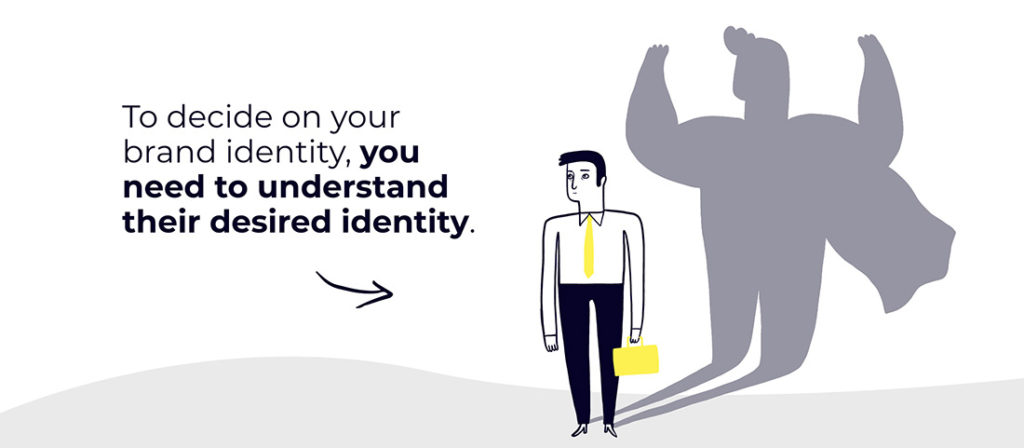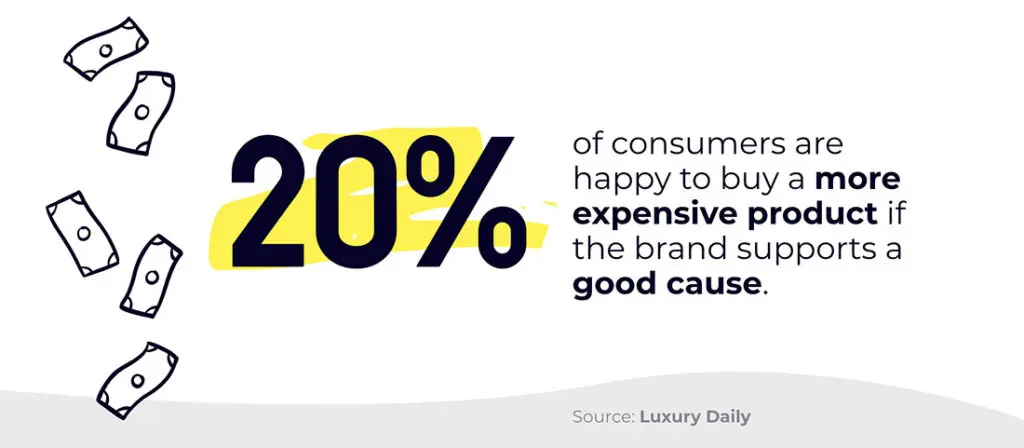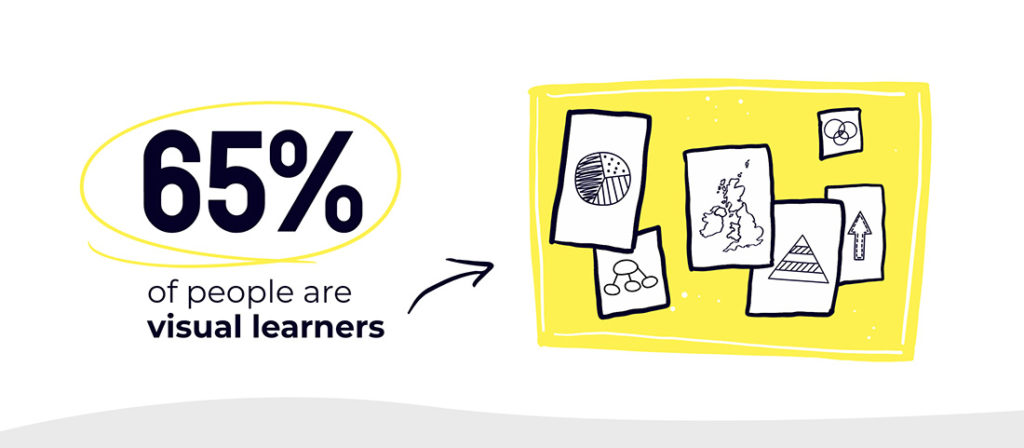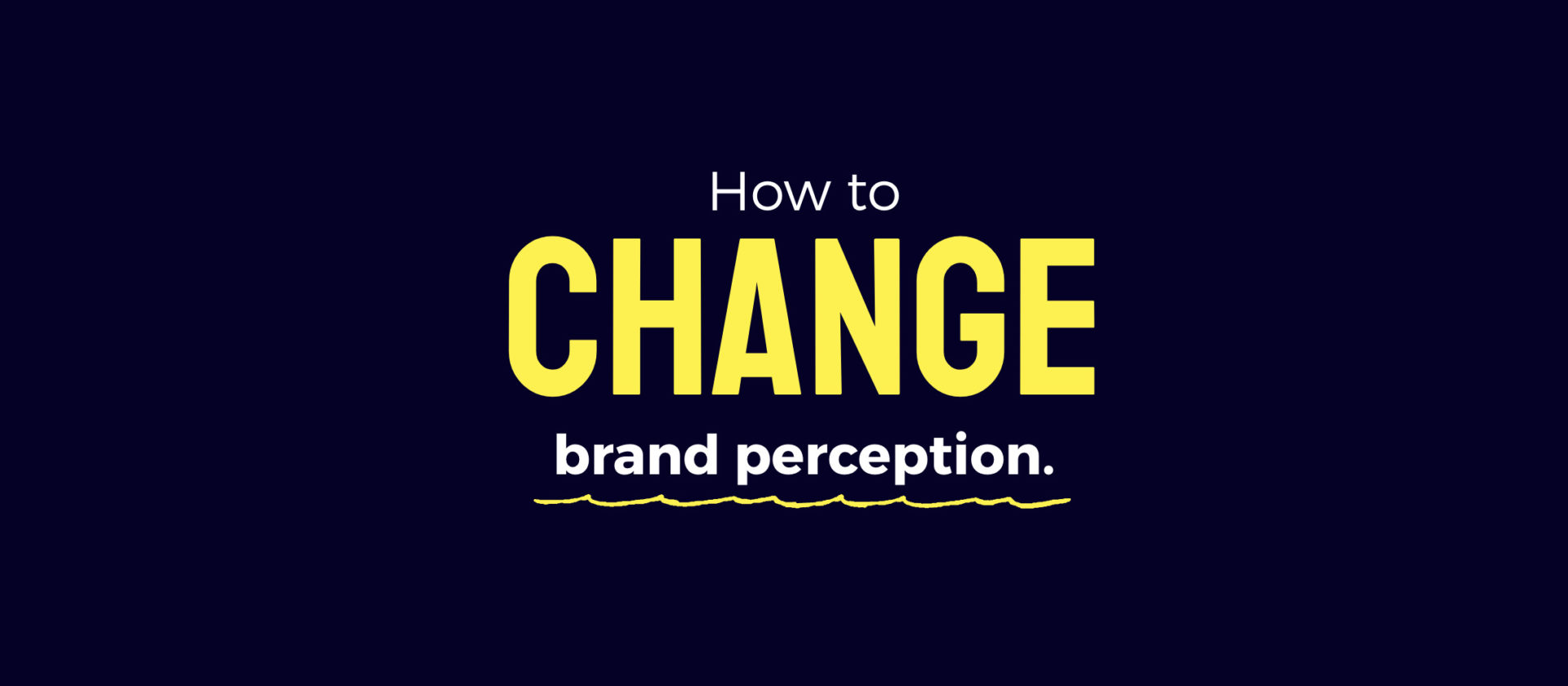Improve your brand perception and watch the sales come rolling in, without having to do as much…you know…selling.
There are two ways to look at increasing profits: sell more or sell smarter. Of course, you could improve your sales win rate, but doesn’t that sound like a lot of work? However, if you increase how valuable your customers believe your products and services to be, not only will you be able to sell at a premium, but they’ll also probably tell their friends all about you and increase your sales rate as well.
What is brand perception?
Brand perception is what customers believe a product or service represents. Brand perception is made of a number of elements, including both first-hand experience and reputation. But perception is just the customer side of the story. As a brand, you’re probably more interested in what their perception means for you: the benefits. By understanding how to change brand perception, you can boost performance in multiple ways. However, this blog will focus on just one: brand equity.
What is brand equity?
Brand equity is a value premium that comes from influencing perception. The extra pennies you can add to your price due to being a recognisable brand, rather than generic. Even if your product is identical in every other way to your competition’s, people will pay more if they’ve heard of you, they remember your name, and they associate your brand with quality.
A great deal of brand recognition comes down to stubborn visibility. As long as all that is visible is also consistent. Check out this brand consistency blog for a detailed look at boosting brand recognition.
As well as visibility, brand equity also comes from aligning with your audience’s idea of quality. If you can find out what quality means to them, you can build an unbreakable connection. You can’t control brand perception, but there are ways you can influence it through your brand identity.
What is your brand identity?
Your brand identity is the message you send out to the world, in every way you communicate. From your logo, design style, and colours to your vision, mission, purpose, and the way you respond to comments on social media. It all adds up to tell customers and potential customers what you’re all about.

At Buffalo 7, we realised our brand identity wasn’t communicating our value. We were telling our audience we could make them stand out, but not backing these claims up by differentiating ourselves in our own industry. So, we rebranded. Now, we sound and look like us and no one else. Now, our credibility to deliver on our promises is apparent from the first interaction through to the last. And our perceived value is on the rise.
If you feel like your brand isn’t telling the right story to get your target audience on board, keep reading.
How to change brand perception: tell your customers what they need to hear
You need to establish what your brand identity currently is – and what it needs to be – early on. Only then can you start thinking about how to change brand perception. It’s the same as any smart change journey. You need to know where you are and where you want to be, before you can figure out the best route.
Don’t just guess. Don’t just ask people from within your company. Don’t go by what the CEO says people think about your brand. Ask the people you want to connect with. Run focus groups. Send out surveys. Scour the internet for mention of your brand name. Or set up Google alerts and have the mentions come to you.
Once you know what your audience thinks about you, keep the conversation going. Find out what problems they’re looking to you to solve. What would make them take action? What’s important to them? The answers to these questions will tell you exactly how you need to position your brand to gain their loyalty.
The emotional sell
Boosting the perceived value of your brand doesn’t mean simply changing your brand identity to ooze luxury. The colour purple doesn’t hypnotise all audiences into being okay with paying above the odds. Changing brand perceptions to be able to increase brand equity means showing customers you can remove a roadblock between their current state and the lives they dream of. To decide on your brand identity, you need to understand their desired identity.

Technicalities – such as product features – aren’t what sticks with consumers. Personal feelings and experiences are stronger influences when it comes to consumer evaluation. Brands that focus on creating positive experiences, becoming an extension of the consumer’s identity, and making them feel good about themselves will form the emotional connections that actually drive purchase decisions, and keep customers coming back.
You don’t have to be Disney or Dogs Trust to connect emotionally. Any brand can do it and it’s certainly worth doing. It’s been shown that connected customers are 52% more valuable, on average, than those who are just highly satisfied. In fact, emotional connection increases value in multiple ways, from brand equity to frequency of purchase and referrals.
Brand identity and your customers’ identity
When it comes down to it, brand perception is tied to personal perception. What does it say about me if I buy from this brand? What will other people think about me?
Nielsen found that 52% of people feel more confident when they buy premium goods. And 47% believe it shows they have good taste. So, what does your brand say about your customers? And, more importantly, what do they want it to say?
The brands we align with become our tribe. Brand community gives customers a sense of belonging. You need to turn your brand into a way they express their identity. One powerful way to do this is to use altruism as a sales tool. But identity is a multi-faceted concept, and the best way to craft yours is by talking to your target audience and finding out what they value most.

Brand perception hero: Apple
Apple is the ultimate cult product. Owning Apple products is such a core part of the tribe’s identity that many will pay thousands and queue for days for each new release. Apple has cultivated this dedication by listening to what customers want and delivering. But it also creates products that they didn’t even know they needed. It solves problems before the customer is aware of them.
Apple invests in developing the best technology and bringing it to market before anyone else. This means that its customers will remain loyal because having the latest tech is part of their identity. Not to mention every time they buy an Apple product, their lives are improved.
How we can help you make customer connections
Customer connection is key to emotional selling. But these connections can’t just be built at the start of your brand evolution and dropped as soon as you understand your audience’s values. They need to be nurtured on an ongoing basis. Yup, forever. And at every customer touchpoint.
By introducing audience engagement and a seamless user experience (UX) to your presentations, you can immerse your audience in your story, create interactions that lead them to discover your solutions for themselves, and make them feel as though they are a part of what you’re doing. Great UX isn’t just for websites. UX carries connotations of how you’ll care for your customers throughout your relationship and shows them that working with you will be easy.
To find out more about the importance of audience engagement – and how to forge emotional connections with your audience in an instant – check out our webinar. Or, get in touch and we’ll do it all for you.
How to change brand perception: the places where we meet
Where customers can interact with your brand can have a huge influence on how they perceive you. When planning your marketing strategy, instead of thinking about the channels you’ve always used, what’s trendy, or what your competition are doing, think about what the channel says about your brand.
If you’re trying to be perceived as helpful and accessible, a magazine ad isn’t going to be as effective as targeting your audience through conversational media, such as online or in-person channels.
If you want to reposition yourself as relevant and youthful, connecting with customers over TikTok would be a better idea than taking out an expensive TV ad.
Using email marketing or LinkedIn has more professional connotations than Instagram, but if you want to establish yourself as a thought leader, providing in-depth, valuable video content over YouTube might be the best fit for you.
Let’s get physical
If your company creates physical products, the stores you choose to stock them in – and even which shelf they’re stocked on – can make a difference to brand perception. If you’re marketing as premium, your products should only be accessible in high-end stores. And the store’s brand identity needs to be aligned with yours as much as possible.
If your products can be purchased online, every website that sells them needs to carry a consistent standard. Low-quality images, bad lighting in videos, off-brand product descriptions, and poor UX will undo all the work you put in to crafting your brand identity.
There’s a lot to think about when it comes to creating a consistent brand identity, but just one small slip up can damage customer trust.
We all want what we can’t have
Where people can find your brand is one thing to consider, but where they can’t find your brand is also a powerful way to increase perceived value. Scarcity is an incredibly effective pillar of modern persuasion, both in terms of limited stock and limited time. If you tell your audience they can’t have something, they’re much more likely to want it.
You can implement this psychological trickery without having to reposition your entire brand, by bringing out a luxury, limited edition product or line of products. Think Tesco Finest and Jonnie Walker Green Label. This is a lower-cost way to increase brand equity, without having to completely rebrand.
Who they can find you with
Another way to promote an exclusive and aspirational brand identity is by partnering with other brands and influencers who epitomise the identity and lifestyle your target audience desires most.
This opens up a whole new place for customers to find your brand and holds the weight of the influencer’s recommendation with it. Influencers are modern brands and anything they’re seen to enjoy becomes synonymous with their lifestyle, and more attractive to the people who want that lifestyle. Make use of this by identifying who your audience admires and letting them discover your brand on the influencer’s channel.
Brand perception hero: Old Spice
Old Spice has been going for a long time and, due to this, had come to represent the after shave of the older generation. Old Spice decided it needed to refresh and change this perception to attract more Millennials.
It refreshed its brand tone of voice, packaging, website, colours, typography, and graphics, but its best move was to create ads featuring American football star Isaiah Mustafa, who’s now commonly known as The Man Your Man Could Smell Like.
This stroke of marketing genius not only meant men wanted to buy Old Spice to be like Mustafa, but it also appealed to women who previously definitely didn’t want their men to smell like their grandad.

How we can help you reach the right channels
PowerPoint is an incredibly useful tool when it comes to cross-channel communications because it’s so easy to use and edit. With just a few clicks, anyone can create on-brand marketing materials and export them in a range of formats. Whether you want to create video ads for LinkedIn, image assets for your website, or visuals for your email campaigns, one PowerPoint template can be used for multiple purposes, while always delivering a consistent brand image.
Talk to us about setting your business up with a multi-purpose PowerPoint template to take the time and effort out of reaching the right people on the right channels.
How to change brand perception: the things you say
As well as adding an aspirational element to your offering, influencer marketing can help in another way: establishing credibility. It doesn’t matter how frequently or loudly you shout about the benefits of your products and services, if you can get someone who your audience already trusts to shout about it, the message is more likely to get through.
But if you don’t have the budget to get celebrities – no matter how minor – on board, there are other ways to establish credibility and raise the value of your brand in your audience’s eyes.
The key here is to tell your story without moving your lips. Gather customer testimonials, write case studies, and ask for referrals. Use your happy customers as an extension of your marketing team and increase your authority in the marketplace.
Other examples of credibility can come in the form of awards, accreditations, and partnerships with brands that already have a trustworthy reputation. And, sometimes, simply raising your prices can give you instant authority.
In a study by Stanford Graduate School of Business, the same wine was given to participants in two different glasses. They were told that one glass held wine priced at $5 per bottle and the other was $45. The researchers found that the pleasure receptors in the brain were more active when the participants were drinking the wine that was perceived to be more expensive. By simply raising your prices above that of the competition, your audience might just believe that you have a better product.
And, of course, you need to back up all your words with actions, or your credibility will be short lived. Your product or service doesn’t have to be the best, but it does have to solve a problem and live up to its promises. Find out where your offering isn’t delivering and improve that weak link – then shout about it.
Brand perception hero: McDonald’s
After a string of documentaries and articles attacking the unhealthy and – according to some claims – downright disgusting menu, McDonald’s changed its ingredients and refocused its messaging.
McDonald’s started to highlight the source of its ingredients in its ads to dispel rumours of ‘added extras’, such as beaks in the nuggets and chicken fat in the milkshakes. It also changed its packaging to be made from recycled materials and introduced more natural colours into its limited palette. This turnaround in identity changed consumers’ perception of McDonald’s, allowing it to fight back against a bad reputation. But more than that, it showed its customers that McDonald’s is a brand that listens and cares about what they want. Unsurprisingly, McDonald’s emerged from this potentially fatal scandal more successful and valued than ever.
How we can help you say the right things
Your corporate presentation story should be the perfect blend of the three pillars of persuasion: emotion, logic, and credibility. Once you have that comprehensive story in place, each time you need to persuade an audience that your brand has the answer to their problems, you can select the parts of the narrative that are most relevant.
For example, by creating a case study section in your presentation that supports every argument you make with a real-world example and words from happy customers, you won’t only have the tools to win any pitch, but also a library of assets. You can use these versatile case studies as part of a creds deck, to sit on your website, or even put into a brochure. Back your emotional story up with credibility and logic and persuade any audience, anywhere.
How to change brand perception: the words you use
Storytelling isn’t just about choosing the right key message for your audience. The tone you use, the level you pitch at, and even the words you choose can make all the difference when it comes to your difference in the marketplace.
You need to speak in a way that will resonate with your audience. Don’t use industry jargon unless you know for certain that everyone your message reaches will know what it means. Don’t use complicate words and ideas, just to show off how clever you are. If in doubt, always explain what you mean. If you lose your audience in the early part of your communications, it’s essentially game over.
Your tone needs to match the need you’re meeting for them. If they’re looking to be guided and informed, more authoritative words should be chosen. If you want your audience to see you as a good friend, your tone needs to be more conversational. If you’re positioning yourself as a luxury brand, try using language that evokes all the senses. And if you want your services to be seen as premium, professional language has been shown to be more effective at achieving this goal.
Brand perception hero: Marks and Spencer
This isn’t just food porn. This is M&S food porn. Its salmon is succulent. Its hollandaise is rich. Its sauce is bubbling. M&S knows how to get our mouths watering when its adverts can’t directly influence taste or smell.
Using adjectives that evoke the senses, combined with a deep-toned, slow, and sensual voiceover, our eyes and ears are all we need to be sold on the quality and luxury of these products.
How we can help you hit the right communication chord
In our Buffalo 7 discovery workshops, we don’t just get to know your brand, products, services, and goals. We spend a long time sharpening our understanding of your audience. And this includes uncovering the language that’s going to strike the right chord for them.
Once we know the voice, tone, level, and style of language that’s right for your brand and your audience, we can roll that out across every deliverable to ensure a consistently-persuasive brand story.
How to change brand perception: non-verbal communications
As well as ensuring your company story is right, there are plenty of design tricks you can use to influence brand perception. Even though we may not always be able to verbalise it, everyone translates everything coming in through their eyeballs into meaning. It plays a massive part in how we understand the world.
If you work with great designers, you can use their knowledge of associated meaning to your advantage. They can make sure every element of your brand style is pointing your audience towards the perception you want them to have of you.
Fonts
Do you want your brand to be seen as sophisticated? Choose a serif font. If you prefer to be known as versatile or sleek, a sans serif might be a better choice for you.
Bodoni commands respect. Tahoma is easy going. Verdana is clean cut. And – for the love of everything – don’t use Comic Sans if you want to be taken seriously.
To narrow your choices right down, check out our blog on choosing the right font for you.
Colours
If you want to add energy to your brand, choosing a red could do the hard work for you. Orange holds connotations of youthful enthusiasm. Green is often associated with sustainability and the environment, but also can be used to suggest stability and heritage. And if you want to scream luxury, a deep, rich purple should always at least be considered.
Different colours have different connotations in different cultures. Make sure you fully understand your target market before hanging too much weight on colour to transport meaning.
Imagery
Researchers estimate that 65% of people are visual learners. But even those who learn through listening, reading, or doing, find imagery in support of the message helpful when it comes to comprehension.

You can tell a story through imagery alone, so make sure the meanings of all your images are in support of your brand story. Especially when using metaphorical images, test them out with loads of people, to make sure everyone is on the same page.
With popular social media sites – such as Snapchat and Instagram – prioritising visuals as a way to communicate with your target audience, it’s a great idea to establish a brand style for imagery. Create robust guidelines that everyone in your company understands and has access to.
Design styles and trends
If you’re wanting to spruce up your brand’s visual identity to better fit your audience, change their perception, and increase your equity, you might want to attach your brand to an established design style and take on the prescribed meaning of that trend. But beware, trends are fickle creatures. You don’t want your brand to go out of vogue before you’ve even rolled the new style out across all your assets.
Some trends, such as minimalism and Scandinavian styles, seem to be standing the test of time. Consider using one of these as a base for your brand, but building unique elements onto it to create something unmistakably you.
Here are some 2021 trends you might get inspired by:
Organic design
If you want your audience to see your brand as caring, the organic design trend might be for you. Use visuals inspired by Mother Nature, alongside neutral colours and free-form shapes, to show your altruism and be bang on trend at the same time.
Nostalgia design
All trends come back around eventually, so why not keep them around? Nostalgia design uses the familiarity of the old to sell the innovation of the new. This trend can be used as a powerful psychological tool. Give your audience those warm, fuzzy, comforting feelings associated with their glory days. Whether you find inspiration in the 90s rave scene or big 80s hair, if your audience have lived through it, they’ll likely live for it.
Brand perception hero: Volvo
There was a time when people were reluctant to say they drove a Volvo. Immediately, the person they told imagined they wore corduroy, had a pocket guard, and preferred to stay in their lane – both on the road, and in life. Volvo had worked tirelessly to create a safe, reliable car and, in doing so, had made its customers appear boring and sensible.
Until it rebranded.
Volvo kept all the safety features, but simply changed how it positioned the brand. It took inspiration from minimalist, Scandi-chic design and gained all the cool points that came with it.
How we can help change brand perception
Our pitch deck designers are lifelong students of design. They came to Buffalo 7 from a variety of design backgrounds. And they love to keep up to date with all the goings on of the various design worlds.
When you work with us, we consider your identity and desired perception at every stage of the project. We will ensure your brand is placing itself exactly where you need to be, from that very first pitch. If you want to know more about how our presentation design services can help you increase your brand perception and equity, get in touch today.


